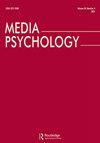附近的人应用程序使用和本地社区经验:通过多层次,多信息方法解开它们的相互作用
IF 2.6
2区 心理学
Q1 COMMUNICATION
引用次数: 4
摘要
摘要本研究调查了个人和社区层面的因素,这些因素影响人们如何使用附近的人应用程序(PNA)与当地社区的人见面。我们认为,个人的当地社会需求刺激了PNA的使用,但这种关系取决于他们的社区特征。采用了多线人方法。314名意大利和荷兰PNA用户回答了一份关于他们当地社会需求(沟通社会资本、孤独感、社区感)以及社区社会和环境特征的在线问卷。结果表明,当当地社区提供社交互动的机会时,与社区相关的PNA的使用有助于用户满足他们的社交需求。当社区提供社交场所时,PNAS的使用与孤独感之间的关系会增加,这表明在这种情况下,人们愿意使用PNAS来对抗孤独感。此外,当邻居已经更加支持时,社区感和PNAS使用之间的关系变得更加消极,这可能意味着如果邻居已经提供了社区感,PNAS使用就不能进一步增加社区感;相反,社会资本和PNAS使用之间的联系变得更加积极。总之,研究结果表明,PNAS的使用与当地社区体验有关,尽管这取决于特定的社区特征。本文章由计算机程序翻译,如有差异,请以英文原文为准。
People-Nearby Applications Use and Local Community Experiences: Disentangling Their Interplay through a Multilevel, Multiple Informant Approach
ABSTRACT This study investigates individual- and community-level factors that affect how people use People-Nearby Applications (PNAs) to meet people in their local communities. We pose that individuals’ local social needs stimulate PNAs use, but that this relationship is contingent upon their neighborhood characteristics. A multiple informant methodology was used. 314 Italian and Dutch PNAs users answered an online questionnaire about their local social needs (bridging social capital, loneliness, sense of community) and their neighborhood social and environmental characteristics. Results show that community-related PNAs use facilitates users to meet their social needs when their local community offers opportunities for social interaction. When the neighborhood offers social places, the relationship between PNAS use and loneliness increases, indicating that in such cases people are willing to use PNAS to counter their loneliness. Furthermore, when neighbors are already more supportive, the relationship between sense of community and PNAS use becomes more negative, which may mean PNAS use cannot further add to a sense of community if the neighborhood already provides this; conversely, the one between bridging social capital and PNAS use becomes more positive. In sum, results show that PNAS use is related to local community experiences, albeit contingent upon the specific neighborhood characteristics.
求助全文
通过发布文献求助,成功后即可免费获取论文全文。
去求助
来源期刊

Media Psychology
Multiple-
CiteScore
8.60
自引率
7.10%
发文量
30
期刊介绍:
Media Psychology is an interdisciplinary journal devoted to publishing theoretically-oriented empirical research that is at the intersection of psychology and media communication. These topics include media uses, processes, and effects. Such research is already well represented in mainstream journals in psychology and communication, but its publication is dispersed across many sources. Therefore, scholars working on common issues and problems in various disciplines often cannot fully utilize the contributions of kindred spirits in cognate disciplines.
 求助内容:
求助内容: 应助结果提醒方式:
应助结果提醒方式:


